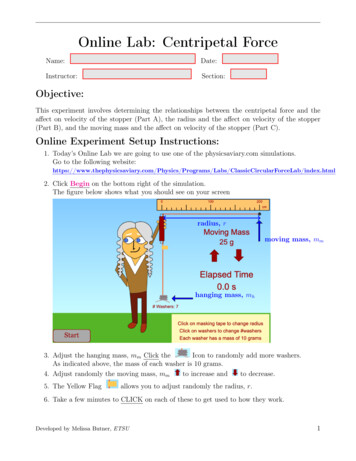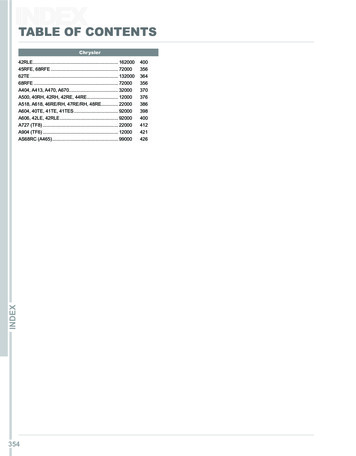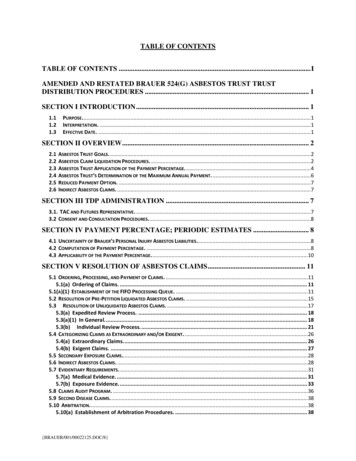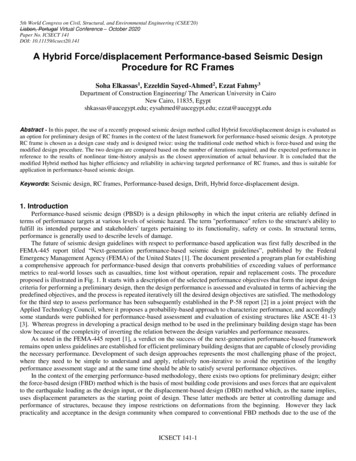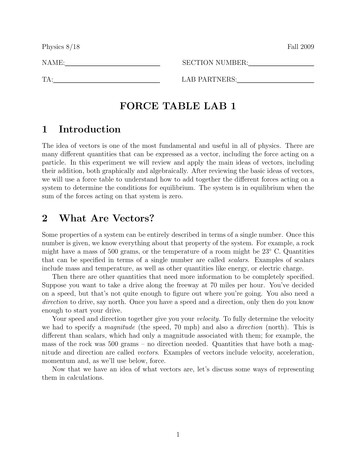
Transcription
Physics 8/18Fall 2009NAME:SECTION NUMBER:TA:LAB PARTNERS:FORCE TABLE LAB 11IntroductionThe idea of vectors is one of the most fundamental and useful in all of physics. There aremany different quantities that can be expressed as a vector, including the force acting on aparticle. In this experiment we will review and apply the main ideas of vectors, includingtheir addition, both graphically and algebraically. After reviewing the basic ideas of vectors,we will use a force table to understand how to add together the different forces acting on asystem to determine the conditions for equilibrium. The system is in equilibrium when thesum of the forces acting on that system is zero.2What Are Vectors?Some properties of a system can be entirely described in terms of a single number. Once thisnumber is given, we know everything about that property of the system. For example, a rockmight have a mass of 500 grams, or the temperature of a room might be 23 C. Quantitiesthat can be specified in terms of a single number are called scalars. Examples of scalarsinclude mass and temperature, as well as other quantities like energy, or electric charge.Then there are other quantities that need more information to be completely specified.Suppose you want to take a drive along the freeway at 70 miles per hour. You’ve decidedon a speed, but that’s not quite enough to figure out where you’re going. You also need adirection to drive, say north. Once you have a speed and a direction, only then do you knowenough to start your drive.Your speed and direction together give you your velocity. To fully determine the velocitywe had to specify a magnitude (the speed, 70 mph) and also a direction (north). This isdifferent than scalars, which had only a magnitude associated with them; for example, themass of the rock was 500 grams – no direction needed. Quantities that have both a magnitude and direction are called vectors. Examples of vectors include velocity, acceleration,momentum and, as we’ll use below, force.Now that we have an idea of what vectors are, let’s discuss some ways of representingthem in calculations.1
2.1Vectors as ArrowsBecause a vector has a magnitude and direction associated with it, we can easily picture it as an arrow, as seenin the figure to the right. We can label this vector asA (often times the vector is instead labeled by an arrow especially when written by hand). The arrowover it, A,has a magnitude (it’s length), and also points in a certain direction, and so it contains everything we need todescribe the vector. A different vector, B, points in adifferent direction, and has a different length, and so adifferent magnitude.2.1.1ABAdding the ArrowsSuppose we want to add together the arrows, Aand B. Why might we want to do this? Supposethe vectors A and B represent displacements; wewalk 1.5 km to the northeast (A), and then turn abit more north and walk another 1 km (B). Howfar have we gone from our starting place? We canfigure this out by adding together the two vectors.Adding together the vectors is as simple as placingthe tail of B on the head of A. Then you draw anew vector C from the tail of A to the head of B.The resulting vector C is the sum of A and B,CBAC A B.We can always slide the arrows around, keeping the length the same, as long as we don’tchange the angles! So, we are always free to put the tail of one vector on the head of the other.Suppose that we want to add the vectors inthe opposite order. In our earlier example,we instead walk mostly north for 1 km, andthen turn toward the east and walk for 1.5km. How far do we go? Do we end upin the same place? In order to add thevectors in the opposite order we start withthe vector B, and place the tail of A onthe tip of B. We then draw the resultingvector C, as in the figure to the left, andsoC B A.ACB2
The resultant vector, C, that we get adding A andB in different orders looks the same, but we cancheck that it really is the same. Consider the diagram to the left, where A and B are added in different orders, combining the previous two figures.It’s clear that the resultant vector is the same inboth cases. So, it doesn’t matter in which orderyou add the vectors,ABCABA B B A.The addition of vectors is commutative.Suppose that we have three vectors, A, B, and C. We can add all three of these vectorsas before, first putting the tail of B on the head of A, then placing the tail of C on the headof B. Then you draw the resultant vector from the tail of A to the tip of C. Or, you couldfirst put the tail of C on the head of B, then put the tail of B on the head of A and drawthe resultant vector as before. The resulting vector is the same in both cases, so(A B) C A (B C) .In addition to being commutative, we say that vector addition is also associative. We canadd as many vectors in this way as we want.A-BWhat if we want to subtract a vector from another? Suppose we start with our vectors A andB, as before. To subtract B from A, all we do isflip B around 180 , making B, and then add itto A, as in the figure to the left. Then we draw aresultant vector, C, from the tail of A to the tipof B. So, this means thatA B A ( B) .CTo subtract A from B is done in the same way,now flipping A around, and putting the tail ofA on the tip of B. Then you draw the resultantvector.3
2.2Vectors in Component FormyRepresenting vectors as arrows is a nice geometric picturethat works well for certain applications, but sometimeswe may want more information than the arrow can provide. For example, suppose we want to know how far thearrow A goes to the right, and how far it goes up. InAyorder to do this, we need a coordinate system. Draw ausual two-dimensional Cartesian coordinate system withAx and y axes, as seen in the figure to the right, with thetail of the vector set at the origin, being careful not toθchange the direction of the vector. The vector makes anangle θ with respect to the x axis.AxxThe tip of the arrow stretches a certain distance along the x axis, which is labeled as Ax .This is the x-component of the vector A. Similarly, the tip of the arrow has a y-component,Ay . So, instead of representing the vector as an arrow with a certain direction, we can specifyit by saying how far it goes along the x and y axes. How do we find these?Suppose that the magnitude of the vector is written as A, without either the boldfacetype, or the arrow over the top. The magnitude of a vector is often written as A A . So,the length of the arrow is A. From the geometry of the figure and Pythagorus’ theorem, wesee thatqA A2x A2y ,where we take the plus sign for the square root since it’s a length. So, if we know thecomponents of the vector, we immediately know it’s length, which is always positive. Wecan also find the angle that the vector makes with the x axis. Again, from the geometry weAy, and sosee that the tangent of the angle, tan θ Ax 1θ tan AyAx .So, knowing the components of the vector, we can rewrite it as a magnitude and direction.Suppose we go the other way; suppose we know the length and direction of A and wantthe components. Again, going back to the figure, and recalling that the length of A is A,thenAx A cos θAy A sin θ.Notice that if we divide Ay by Ax we get tan θ, as before. So, we now have the componentsof the vector, and we can express it in terms of these components. There are several waysto do this. One way is to give the components in parenthesis, A (Ax , Ay ). However, thereis a more common way that we will use.4
We’ve expressed our vector by saying how faralong the x axis it goes (the x component), andhow far along the y axis it goes (the y component). Consider the figure to the right. Using theideas of adding vectors that we discussed before,we can writeA B C,yAwhere the vector B is entirely along the x axis,and C is entirely along the y axis. In otherwords, we write the vector A as the sum of twovectors - one along x and the other along y.Choosing our vectors to lie along these axes is avery convenient basis to use.CθBxNow, what are the vectors B and C? The length of B is just the x component of A, B B Ax . Similarly, the length of C is just the y component, C C Ay . Becausewe can always describe a vector as a magnitude and a direction, we can say that B has alength Ax , and points along the x axis. Now, a convenient notation for a vector that pointsalong the x axis is to give it’s length, multiplied by a unit vector, î, which has a length of 1,by definition. So, suppose that the vector B has a length 3 and points along the x axis. Itcan then be written as B 3î. More generally for us, B Ax î, since the magnitude of B isAx .What about the vector C? We can express C as a vector of length Ay , pointing along they axis. We can just do the same thing as before, writing C Ay ĵ, where ĵ is another unitvector, this time pointing along the y axis. So, since A B C, we can plug in B Ax î,and C Ay ĵ, to finally findA Ax î Ay ĵ.This is a complete specification of the vector A in terms of it’s components. Sometimes theunit vectors are denoted slightly differently, writing x̂ and ŷ instead of î and ĵ, but it’s justa notation. We’ll stick with î and ĵ.So far, all the vectors that we have discussed hadonly two components, Ax and Ay , correspondingto a two-dimensional vector. This is useful fordrawing vectors on a 2D piece of paper, but wereally live in three dimensions, x, y, and z. Forexample, suppose you walk 4 meters straightahead, turn left and walk 3 meters, and thenclimb 2 meters up a ladder. How far away fromyour starting point are you? The vector thatwould connect your final spot to your startingplaces now moves along all three axes, as seen inthe figure to the right.zAyxIt’s very straightforward to generalize the vector to three dimensions. All we have to do5
is to add a piece that tells us how far the vector moves along the z axis. If the componentalong the z axis is Az , and if we denote the unit vector along this axis as k̂, then we canwrite the vector asA Ax î Ay ĵ Az k̂,where the length of the vector is now A A qA2x A2y A2z .Notice that if the vector doesn’t go into the z axis (meaning that Az 0), then we get backthe old 2D result. For what follows we’ll limit ourselves to the 2D case, but the expressionsgeneralize straightforwardly.2.2.1Adding the ComponentsWe’ve seen how to add two vectors graphicallyby adding the arrows. How can we do it using ythe components? Consider the figure to the right,where we add the vectors A and B to get the resultant vector C. Using the ideas discussed above, Bywe can write the resultant vector asC Cx î Cy ĵ.How do the components Cx and Cy compare toAthe components of A and B? From the figure, we ycan see that Cx stretches along the x axis, andis given by the sum of the Ax component, whichstretches from the origin to the point labeled Ax ,plus the Bx component, which stretches from thepoint Ax to the point Bx . So, Cx Ax Bx .It’s easy to see that Cy Ay By in the same way.CBθBAθAAx BxSo, it seems clear that to add two vectors, we just add the components. Let’s see howthis works algebraically instead of geometrically. We know that we can write C Cx î Cy ĵ,in general, while A Ax î Ay ĵ, and B Bx î By ĵ. So, C A B, gives Cx î Cy ĵ Ax î Ay ĵ Bx î By ĵ (Ax Bx ) î (Ay By ) ĵ,after collecting the terms. Now, the unit vector î points along the x axis, while ĵ pointsalong y. These two vectors point in perpendicular directions, and are independent of eachother (how far the vector stretches along x has nothing to do with how far it goes along y).This means that we can compare the left- and right-hand sides of our expression and matchthe coefficients of the unit vectors. This means thatCx Ax BxCy Ay By .6x
So, it really is true that we just add the components to add the vectors. What if we want tosubtract two vectors, in terms of the components? Recall that A B A ( B). Now, B Bx î By ĵ Bx î By ĵ. So, adding the negative of B means that we justsubtract the components,A B (Ax By ) î (Ay By ) ĵ.Thus, completely generally we haveA B (Ax By ) î (Ay By ) ĵ (Az Bz ) k̂.2.3Rotating the Coordinate AxesWe began our discussion of vectors by describing them as arrows pointing along a certaindirection. This is the purely geometrical description of the vector that doesn’t need any sortof coordinate system - we drew the arrows without any axes. Later we introduced a coordinate axis so that we could figure out the components of the vector. We decided to draw aparticular axis such that the vector made an angle θ with respect to the x axis. This gaveus components, Ax A cos θ, and Ay A sin θ. But - we just introduced that coordinatesystem, without any real motivation. How do we know it’s right? What if someone else useda different coordinate system, such that the vector made a different angle with respect tothe x axis? Wouldn’t the components be different?Let’s try to figure this out. Suppose thatwe look at our coordinate system, andthen imagine that someone else uses a y’different coordinate system that is rotatedrelative to ours by an angle φ. This meansthat the new x and y axes, denoted witha prime, x0 and y 0 , are rotated by φ. Wesuperimpose the two coordinate systemsas in the figure to the right. Notice thatwe haven’t touched the vector at all! Now,we still see the same components for thevector, Ax A cos θ, and Ay A sin θ.What does the other person see?yAyx’AAx’αAy’θφAxThe other person sees new components, Ax0 and Ay0 , because they are using new axes.If the vector makes an angle α with respect to the x0 axis, then the other person findsAx0 A cos α, and Ay0 A sin α. Now, from the diagram, α θ φ, and soAx0 A cos (θ φ)Ay0 A sin (θ φ) .So, unless φ 0 (meaning we use the same coordinates), we don’t see the same compone
TA: LAB PARTNERS: FORCE TABLE LAB 1 1 Introduction The idea of vectors is one of the most fundamental and useful in all of physics. There are many di erent quantities that can be expressed as a vector, including the force acting on a particle. In this experiment we will review and apply the main ideas of vectors, including
